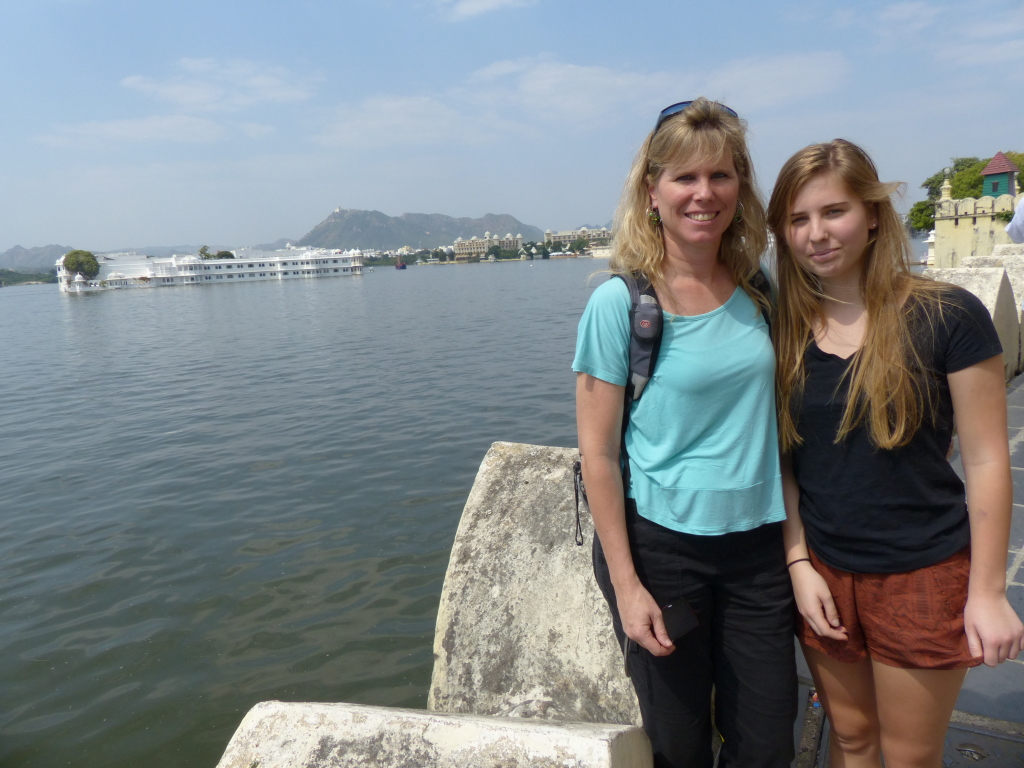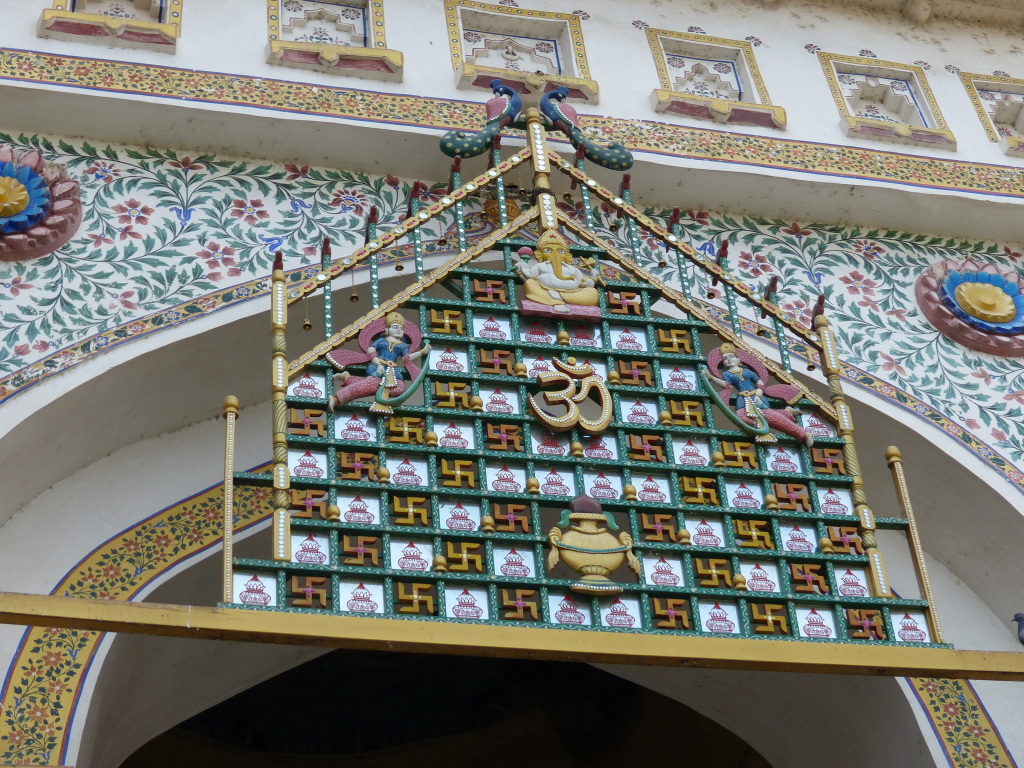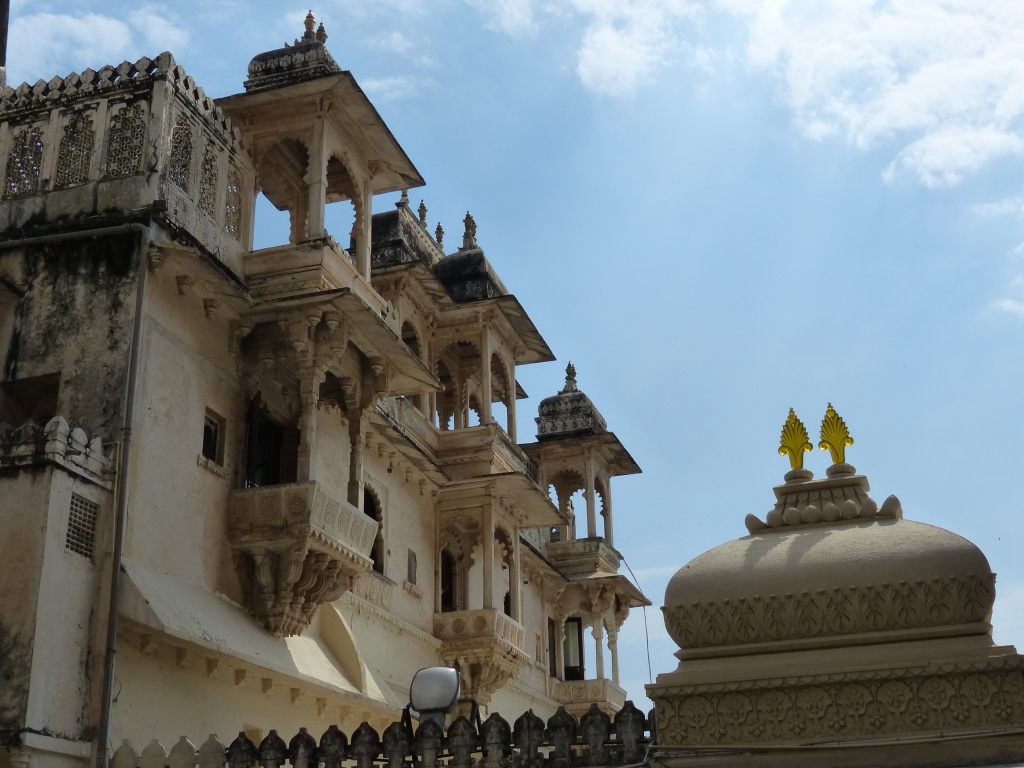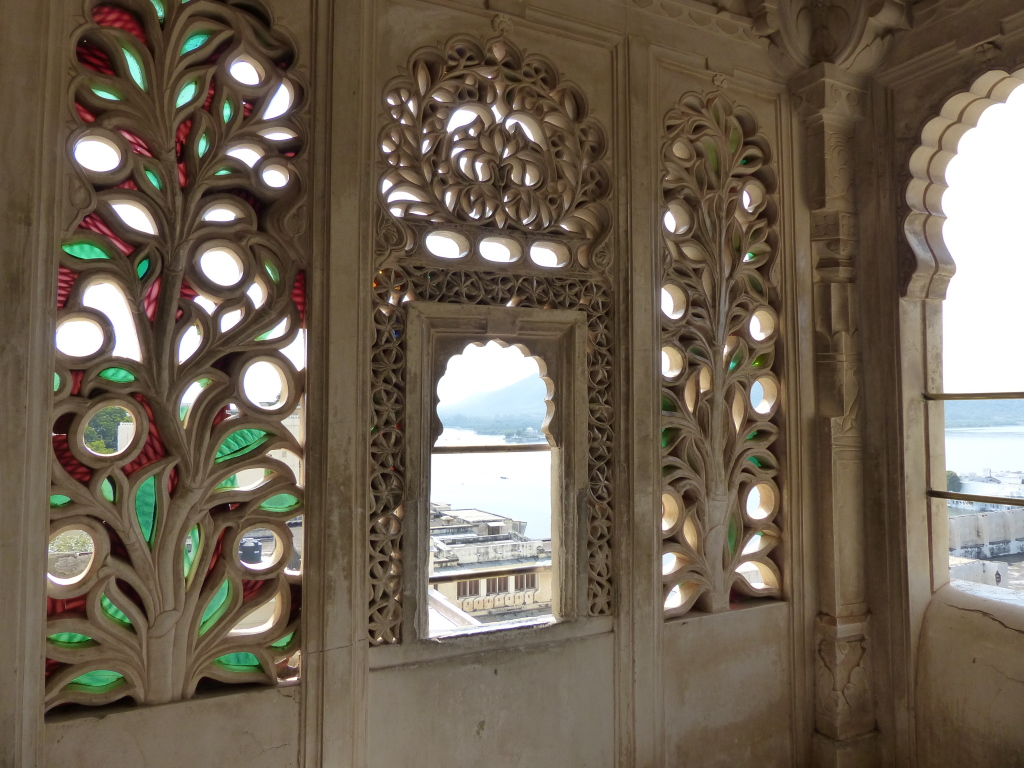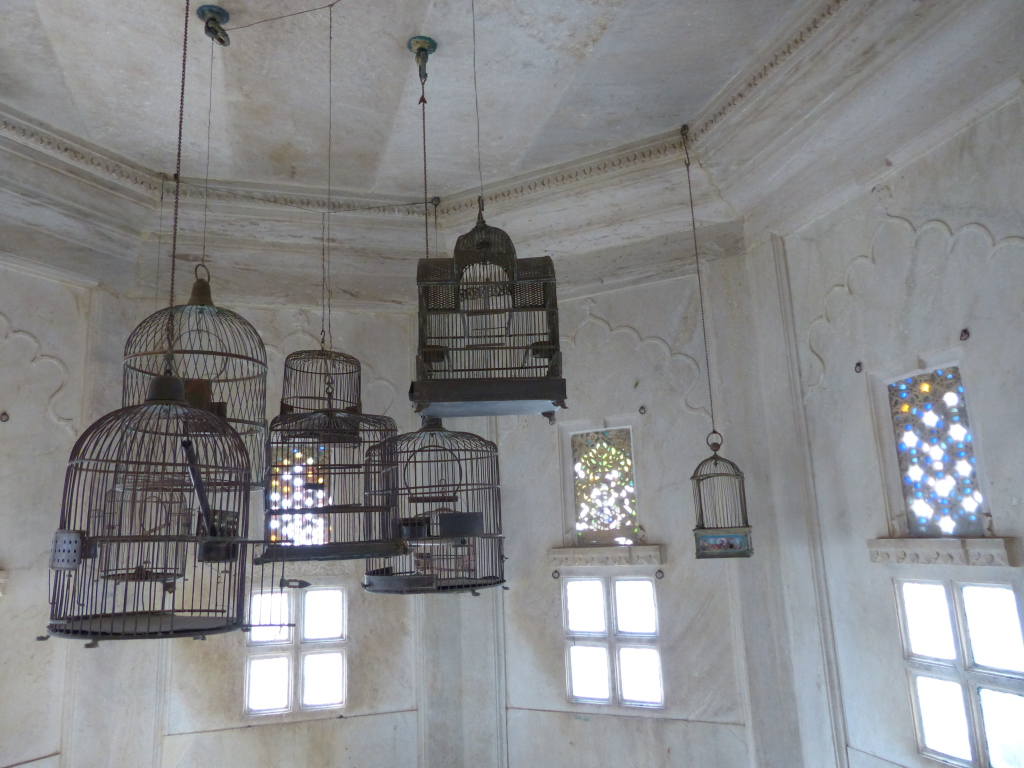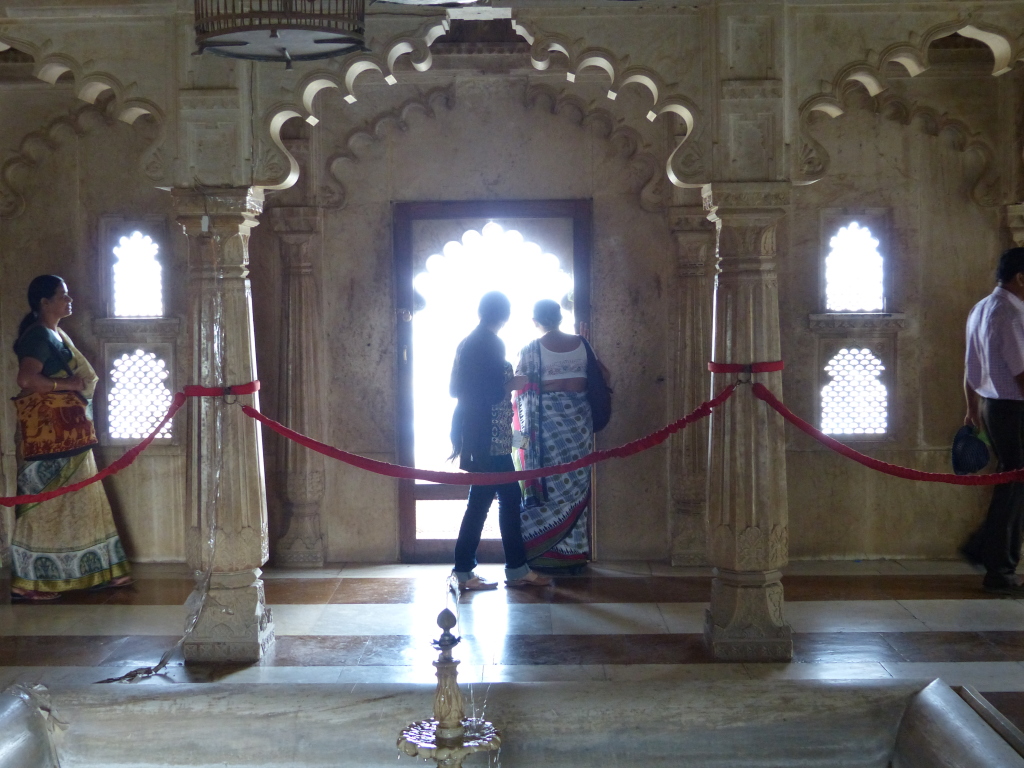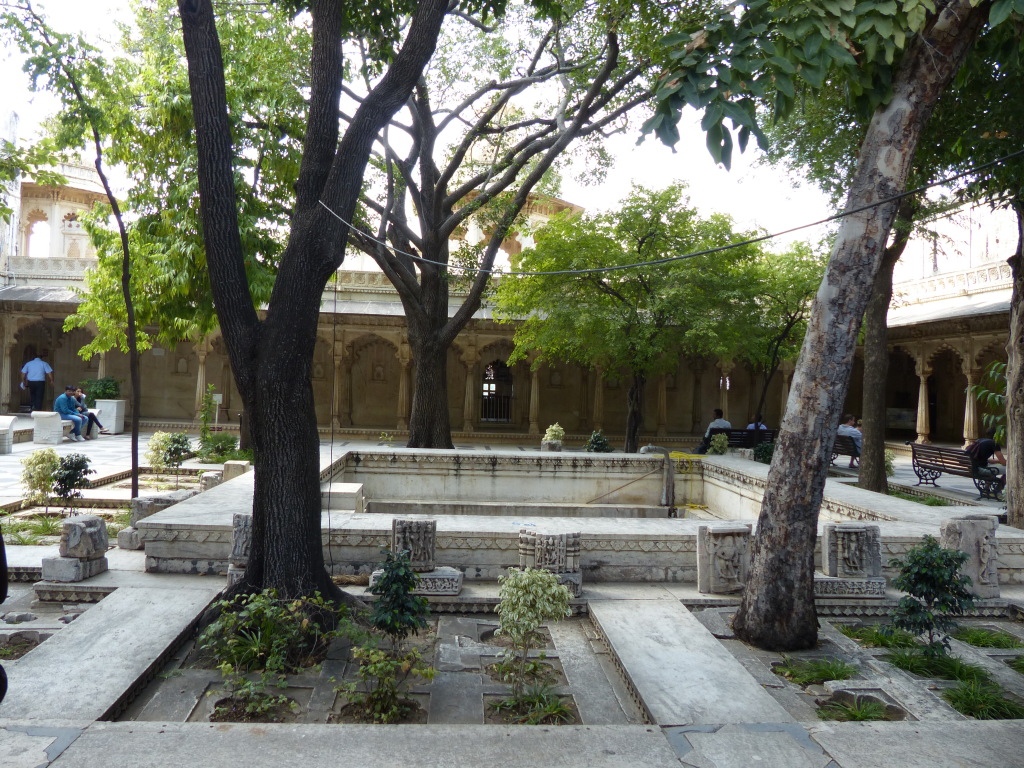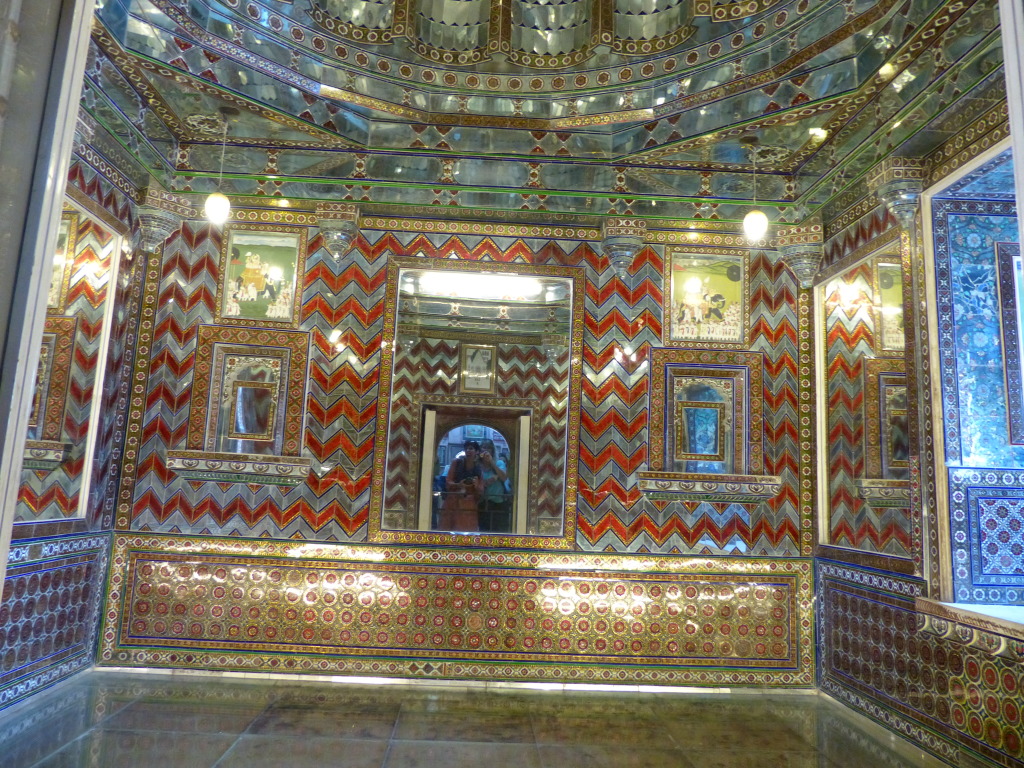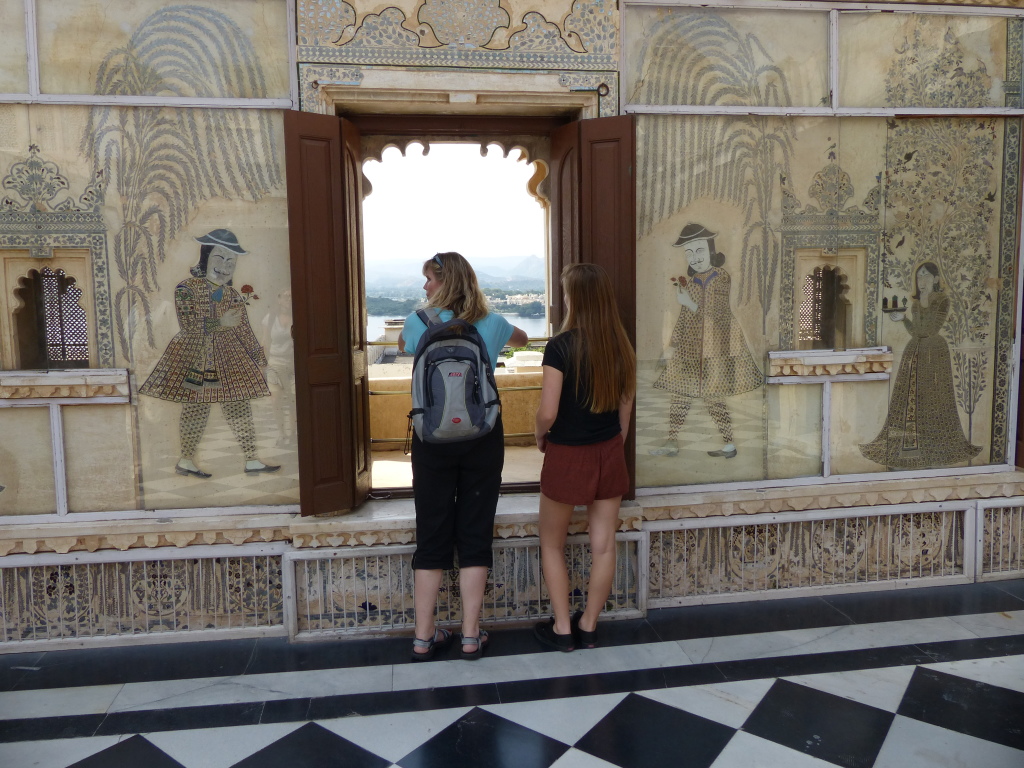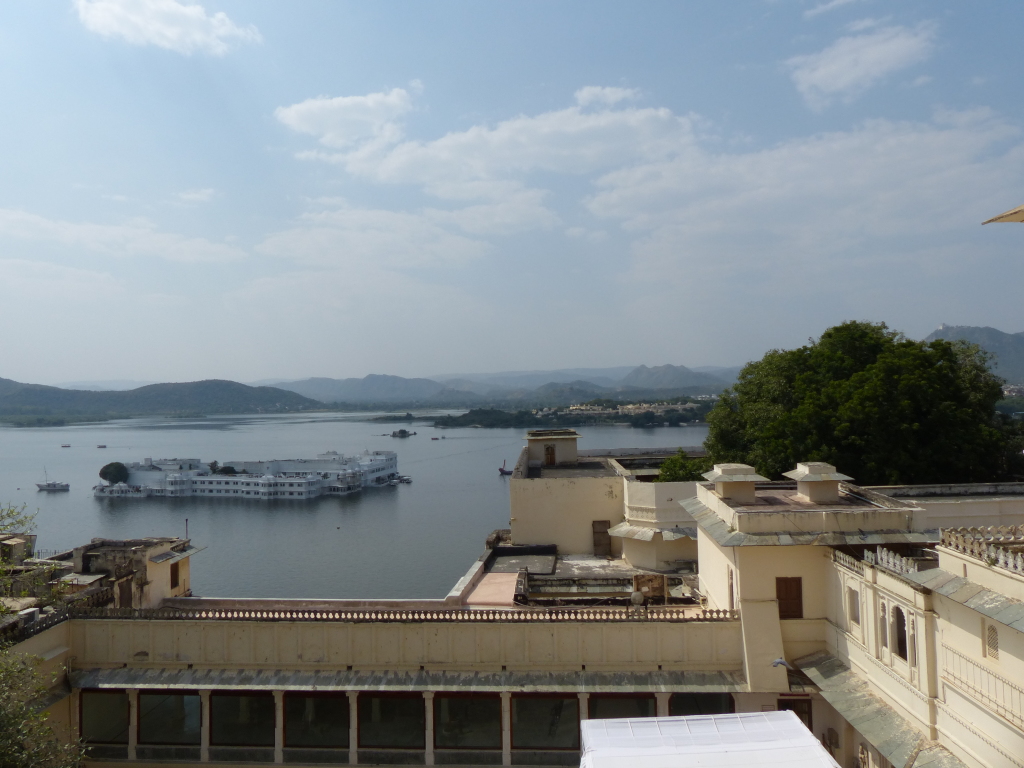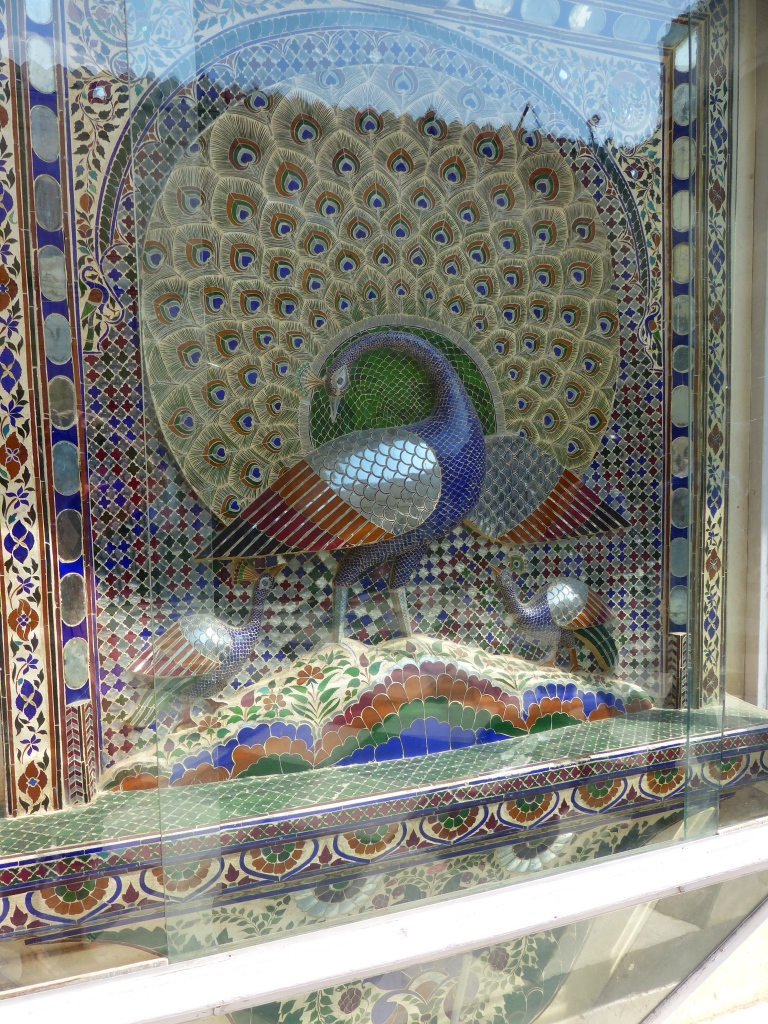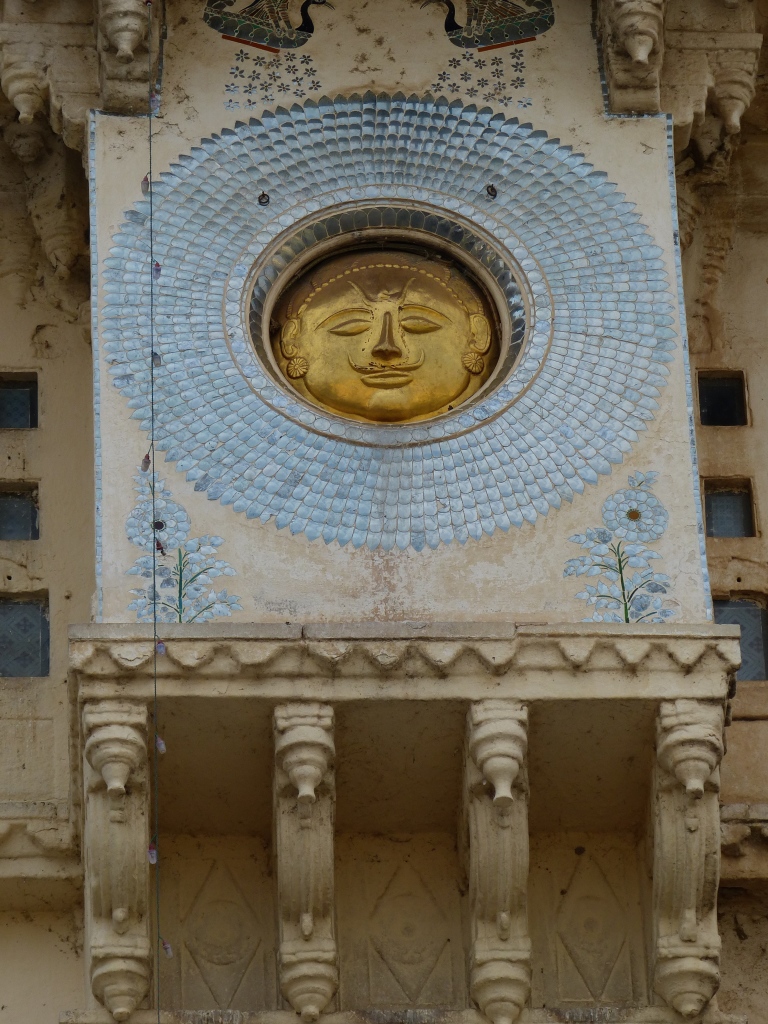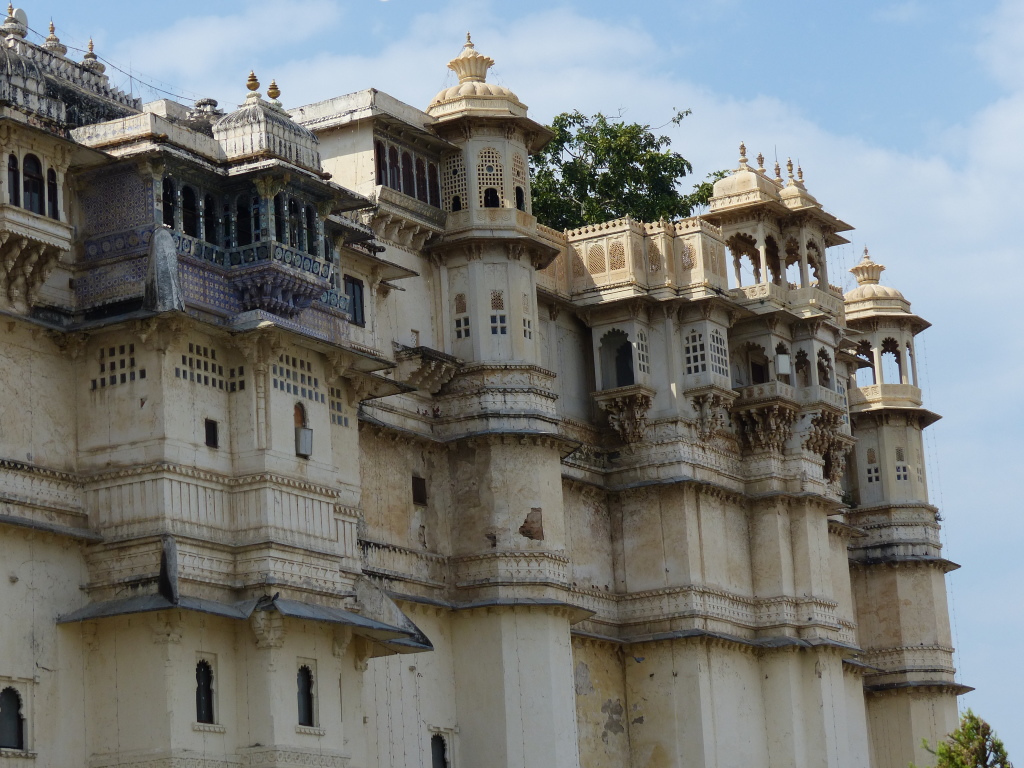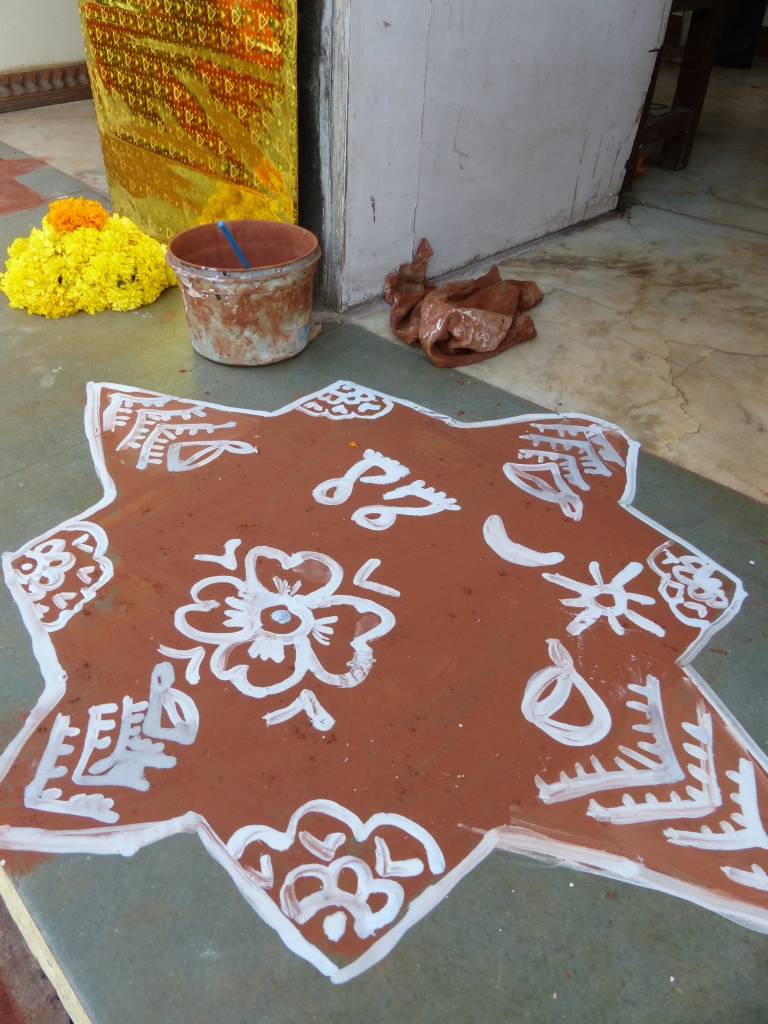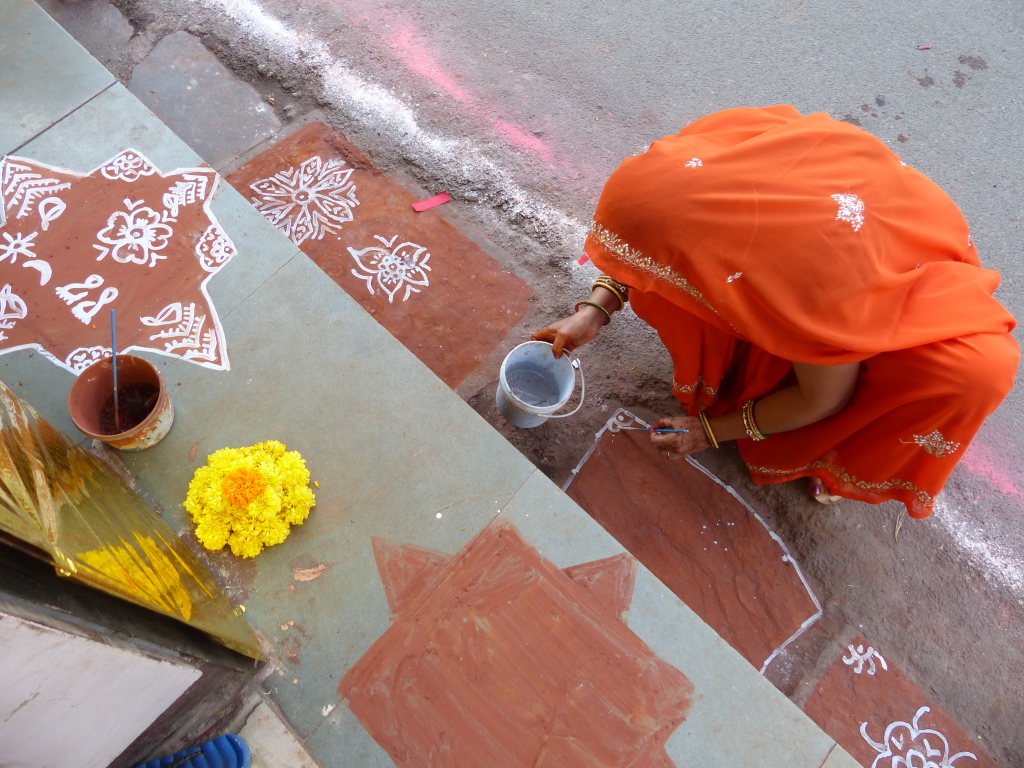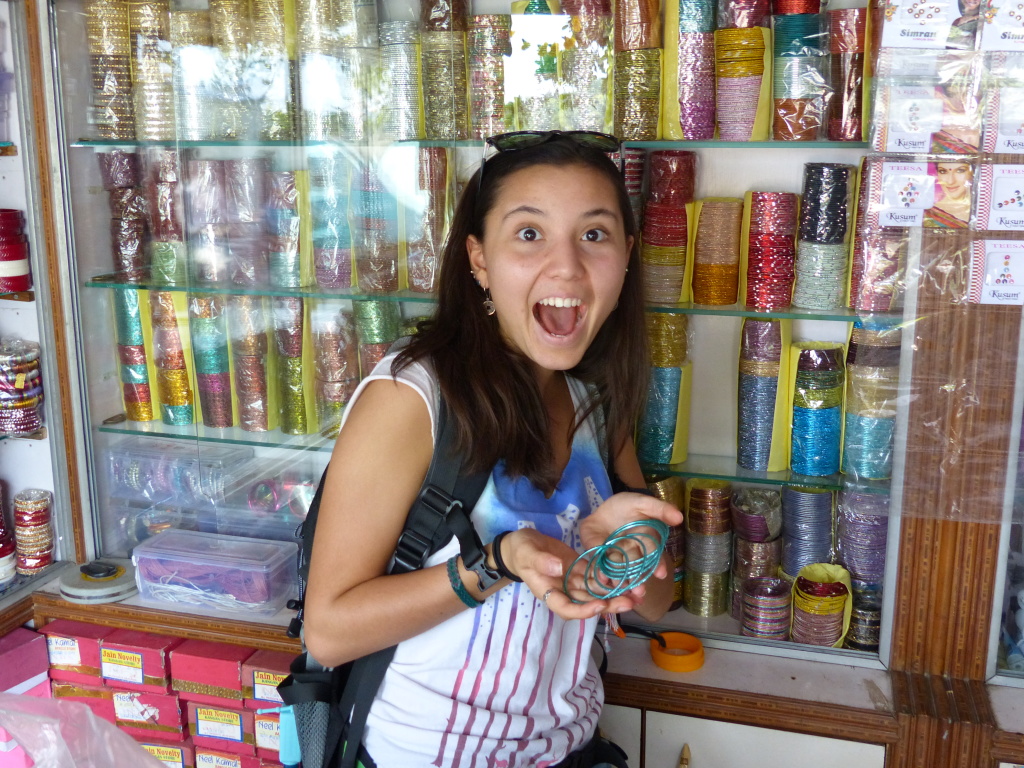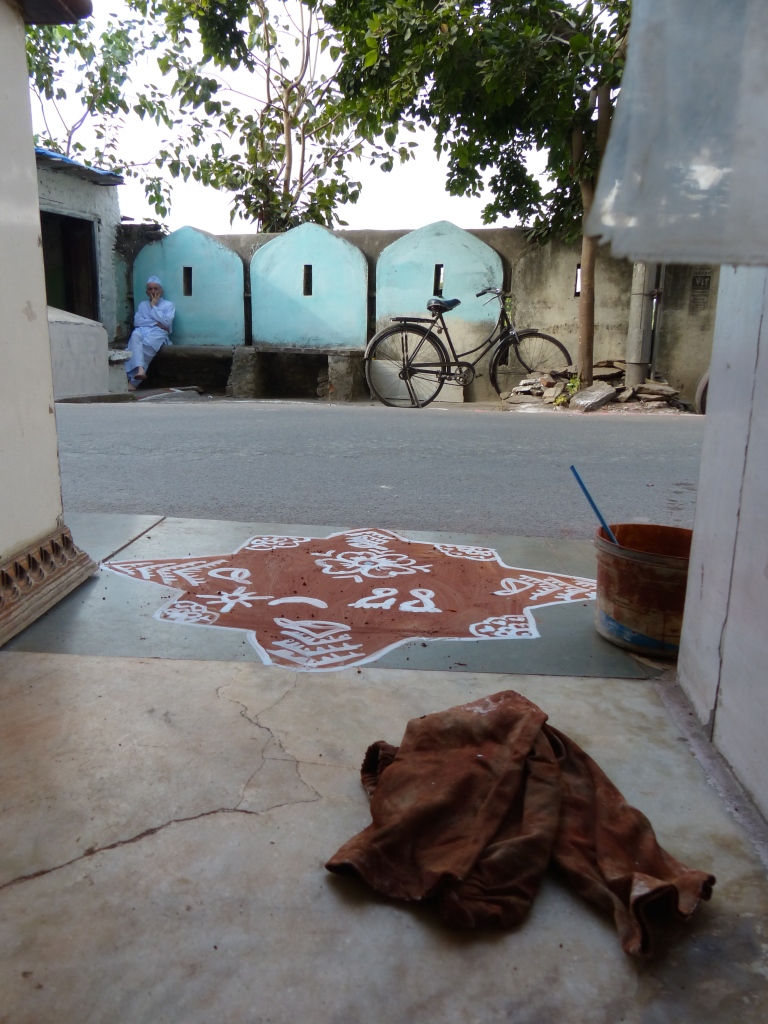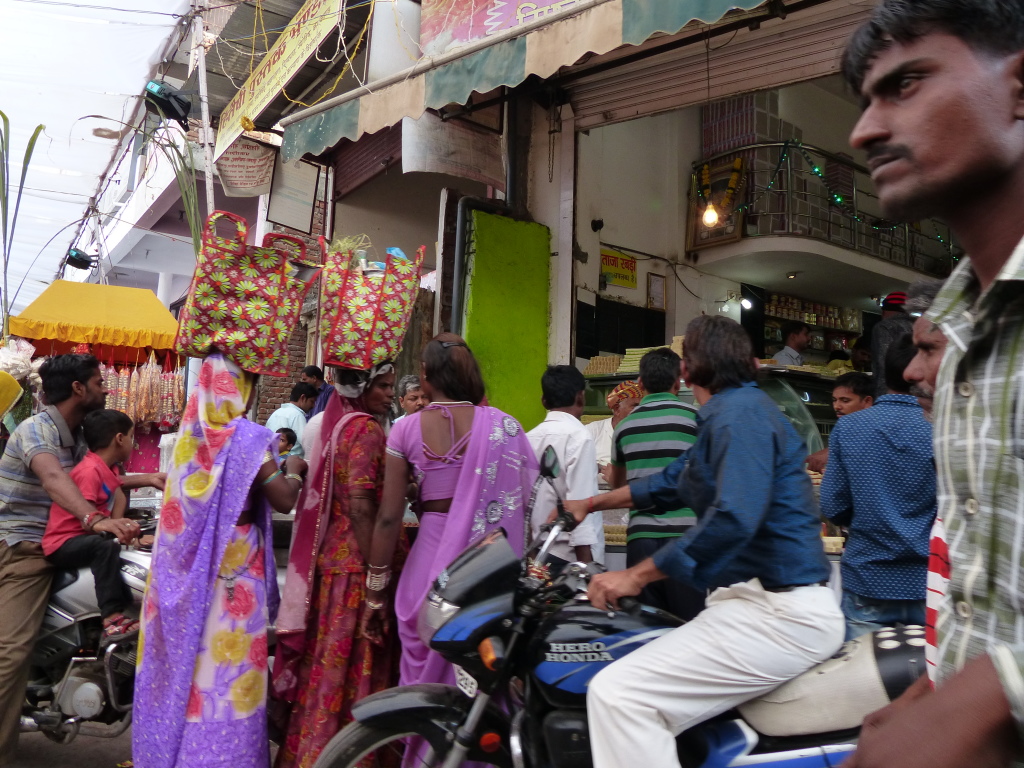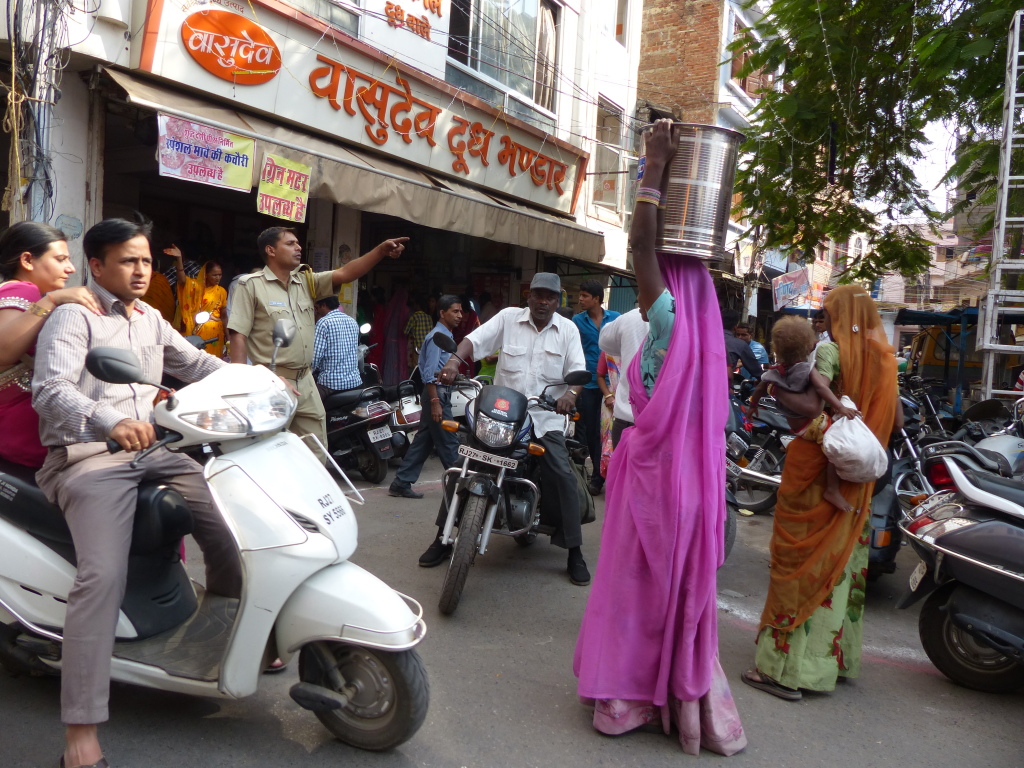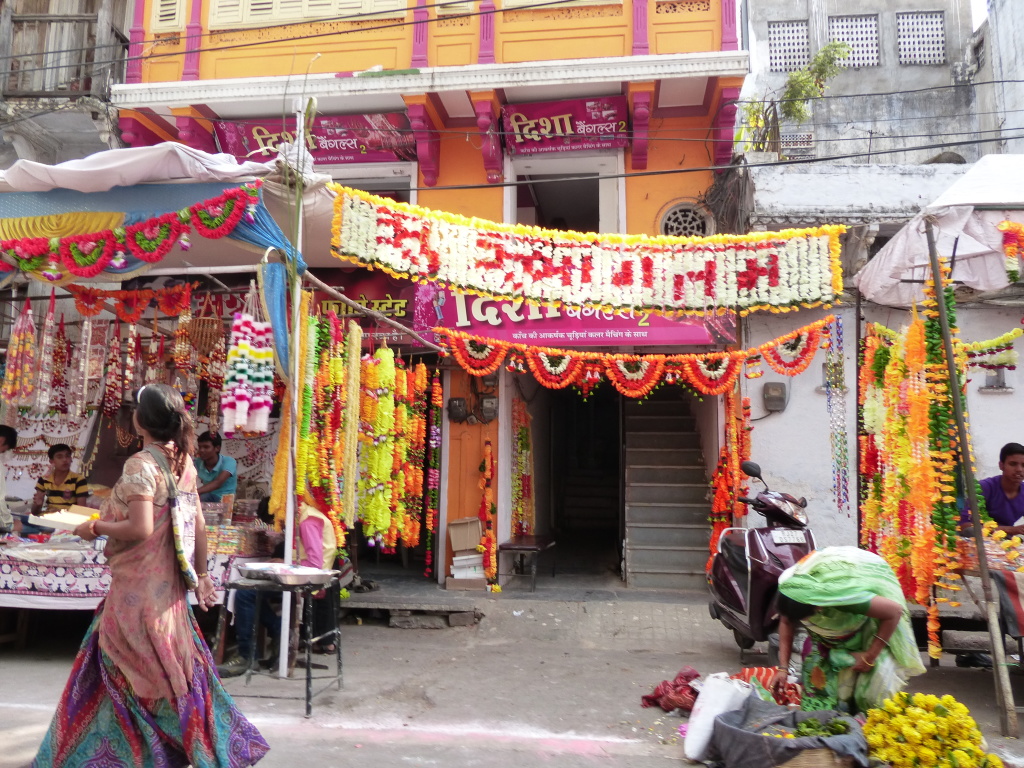Just an hour’s flight from Delhi, and I awoke to this view.
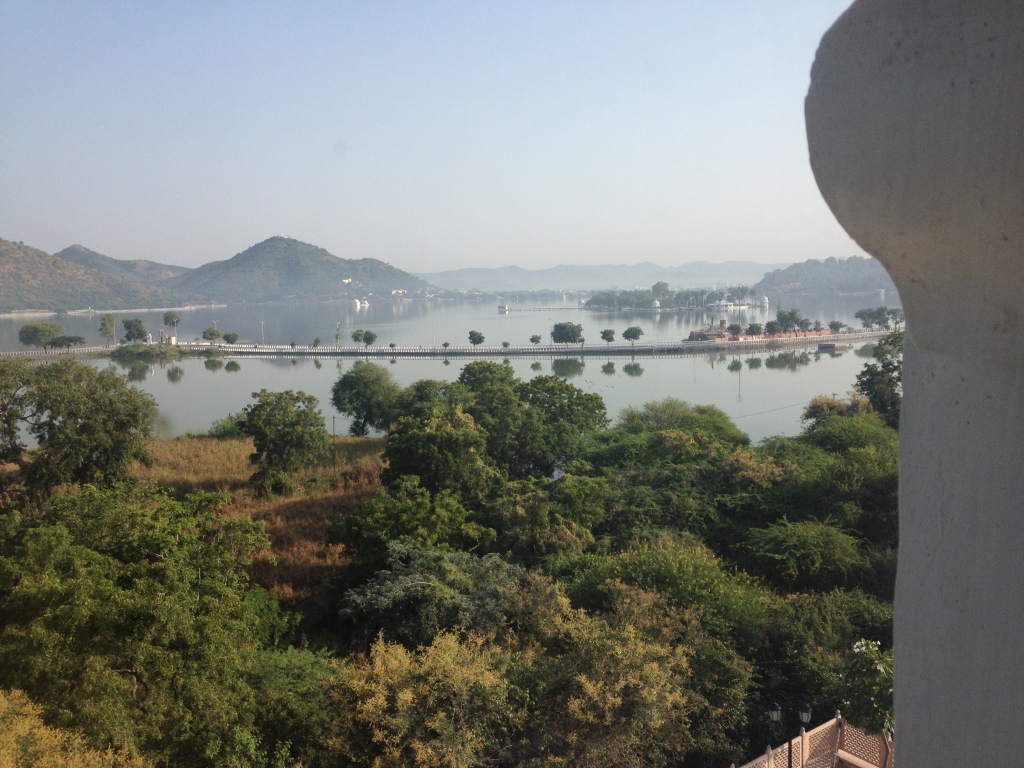
I spent the Diwali weekend in Udaipur with friends from Shanghai, Colleen and Ronna, and their daughters. Col now works in Hong Kong, but Ronna joined the AES staff this year, so we’re colleagues again. Small world!
We stayed at the Radisson Blu, which overlooked the Fateh Sagar Lake.
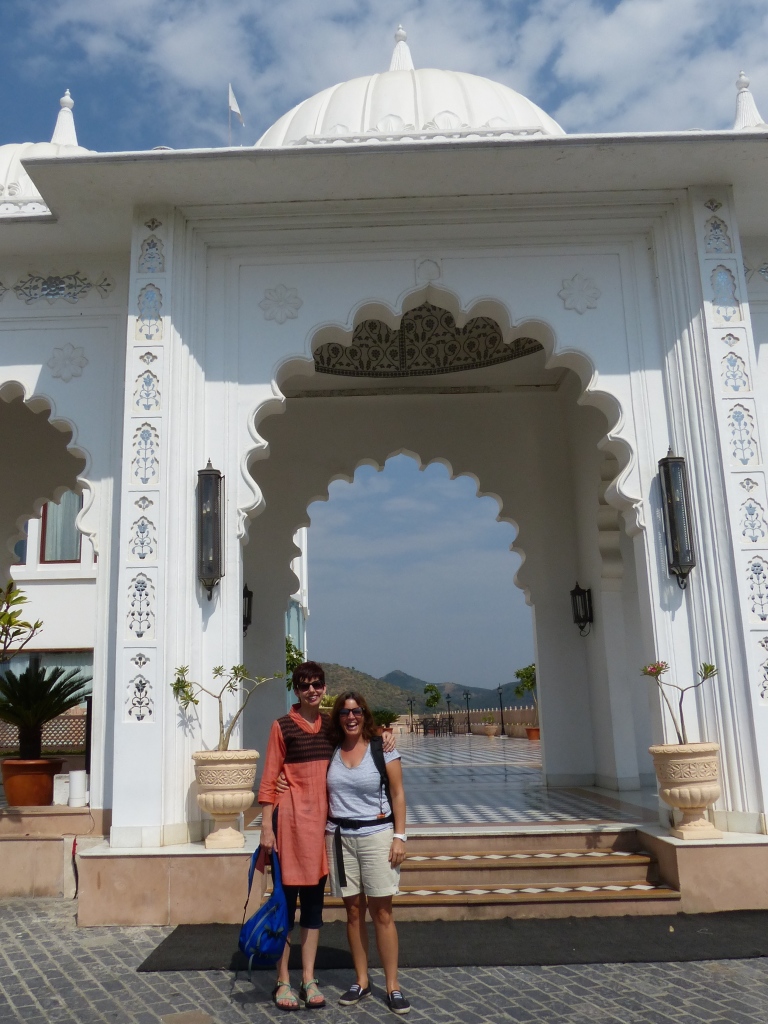
Although relatively peaceful by India standards, the pool and restaurant were completely overrun by young children. Fortunately, we were upgraded to suites and had plenty of room to spread out and lounge. We escaped from the noisy restaurant to enjoy leisurely breakfasts outside under a canopy of morning glory.
The staff created Diwali rangoli in the lobby, and we were told to vote on our favorite.
“I like them both,” I said. “I can’t pick.”
“You must,” said a bossy supervisor.
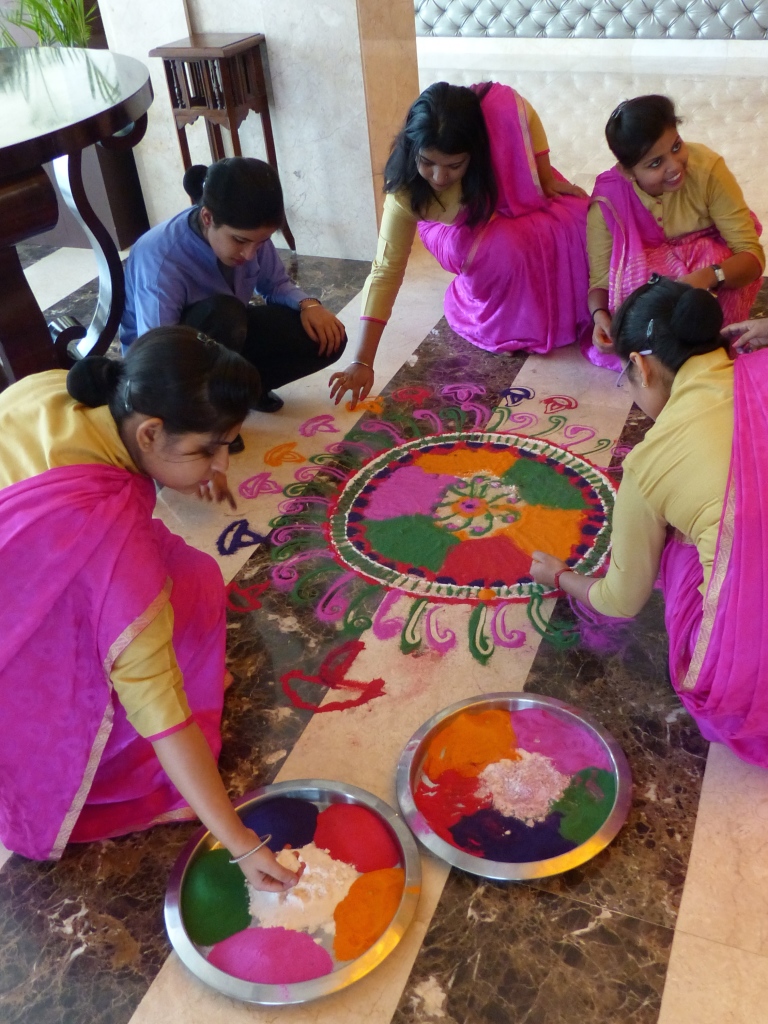
On our first day, we caught a couple tuk-tuks to the City Palace. Walking to the gate, we had a nice view of the Lake Palace, now a Taj Hotel. A rich lady who attends my yoga class in Delhi had encouraged me to stay there. Last I checked, the cheapest room was about $730 a night … so … yeah.
Brenna, you teeny thing, no need to “mind your head.”

I couldn’t resist hiring a guide at the gate. I am, after all, The Guide Hog. (See my previous post about my Guide Hog Jr.)
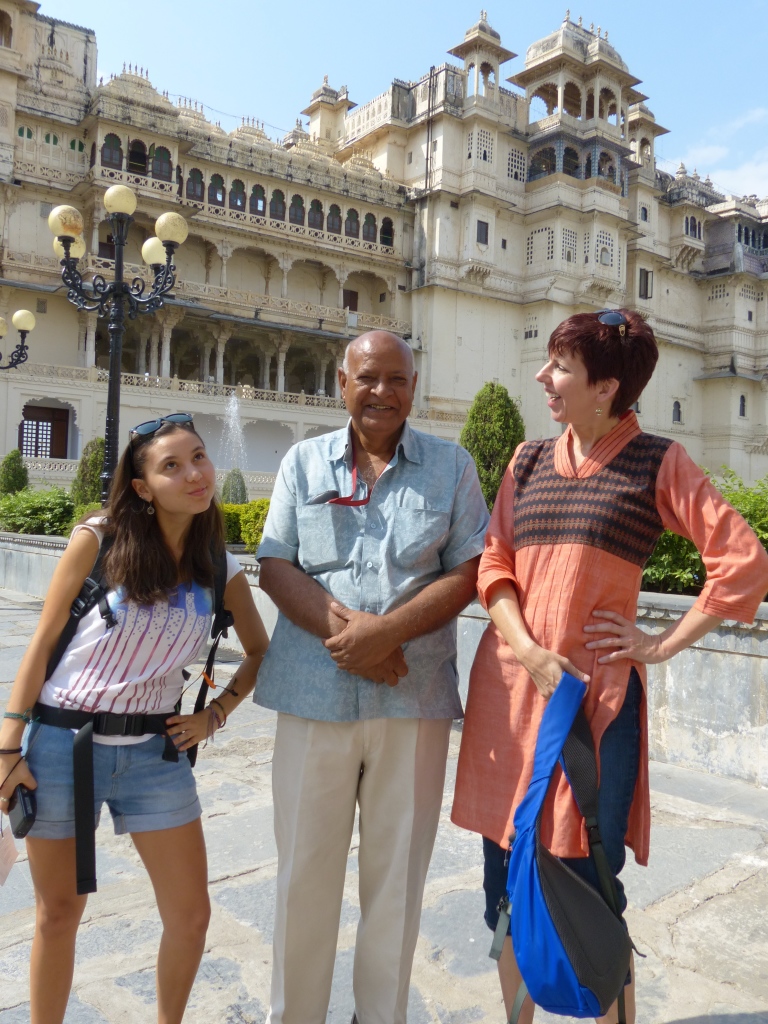
Here’s what we learned: Maharana Udai Singh, 53rd ruler of the Mewar Dynasty, founded the city of Udaipur after a holy man advised him to build his palace on the hill. He started construction of the palace complex in 1559 on the east bank of Lake Pichola, and successive kings added on to the palace for the next 300+ years.
Just nine years after moving to Udaipur, Udai Singh lost his kingdom to Mughal Emperor Akbar (grandfather of Shahjahan, who build the Taj Mahal). In 1572, Udai Singh’s son Pratap led a Rajput army against Akbar’s forces in the legendary Battle of Haldighati. The palace museum features paintings of this battle, as well as a statue of Pratap’s horse, Chetak, wearing an elephant mask. Our guide, Mr. Singh, explained that in battle, neither horses nor elephants will charge a baby elephant. So Chetak’s disguise bought time for his rider. Chetak died in the battle, but despite being fatally wounded, he carried Pratap to safety. The Rajputs later won back their freedom and territory from the Mughals.
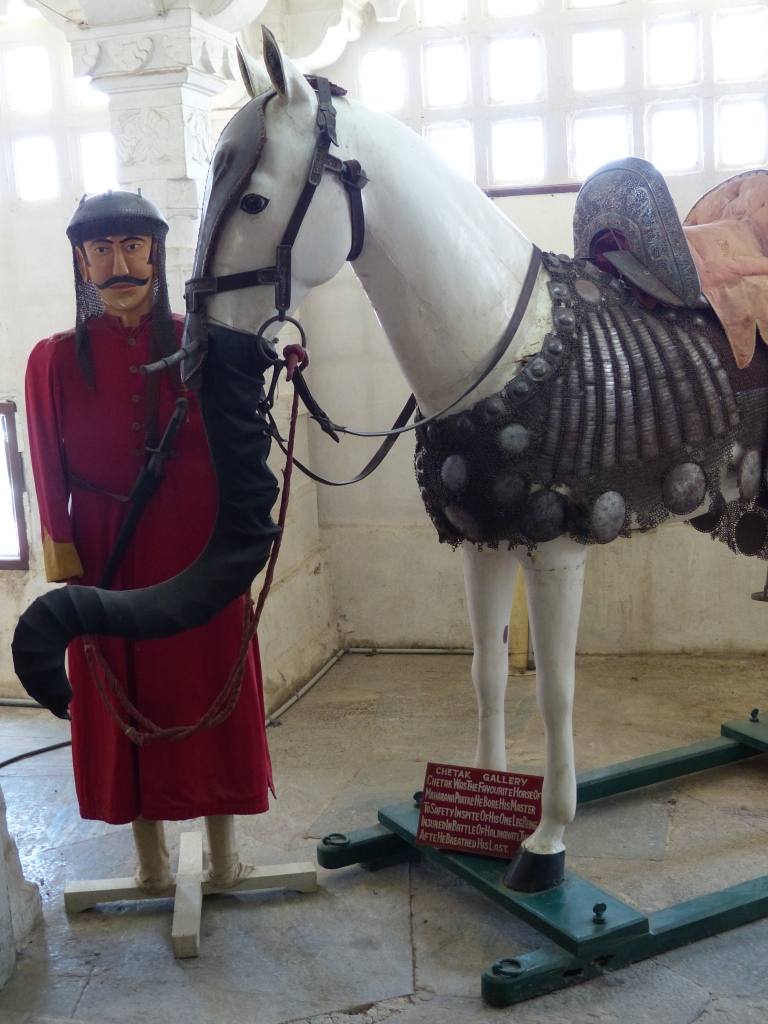
Built of granite and marble, the complex comprises 11 interconnected palaces that reflect European, Chinese, Rajasthani and Mughal architecture with cake-topper cupolas, multi-level balconies, carved lacy screens, gardens, terraces, colonnades, and fountains. A couple sections of the palace now operate as heritage hotels.
According to Wikipedia:
Once India got independence in 1947, the Mewar Kingdom, along with other princely states of Rajasthan, merged with the Democratic India, in 1949. The Mewar Kings subsequently also lost their special royal privileges and titles. However, the successor Maharanas have enjoyed the trust of their people and also retained their ownership of the palaces in Udaipur. They are now running the palaces by creating a trust, called the Mewar Trust, with the income generated from tourism and the heritage hotels that they have established in some of their palaces. With the fund so generated they are running charitable hospitals, educational institutions and promoting the cause of environmental preservation
A cardboard cutout of Bhupal Singh, paralyzed at the age of 16, tells that he was the first Rajasthani ruler to sign an Instrument of Accession to join the new Union of India in 1948 and the last Mewar ruler to reside in the palace.
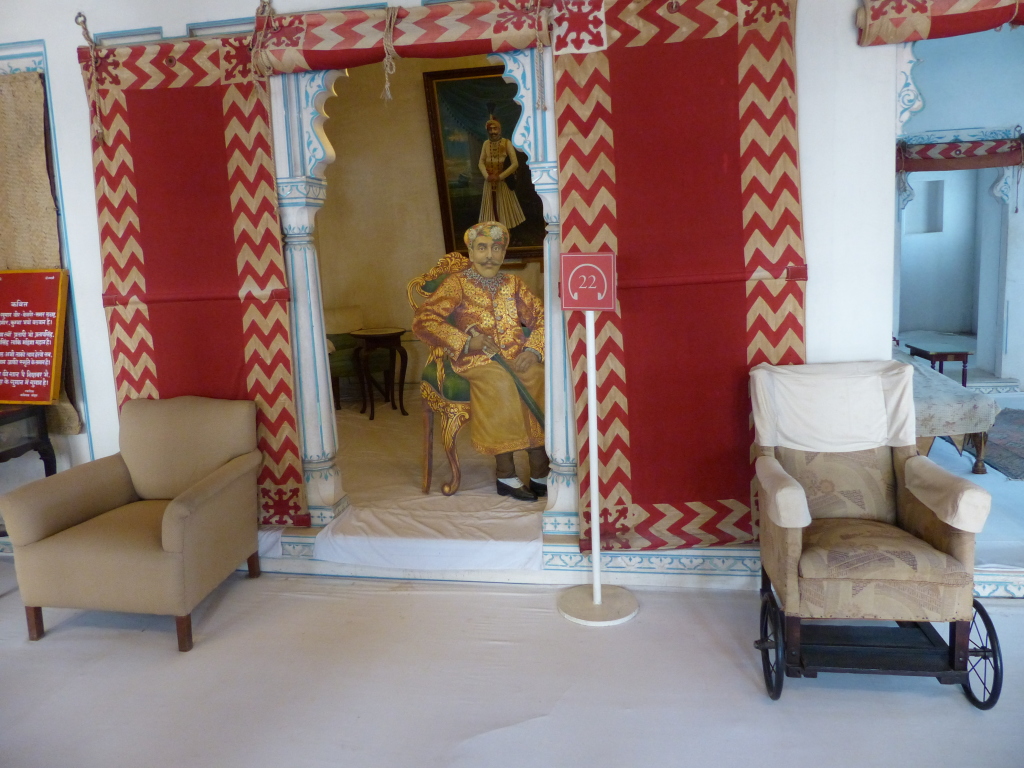
Mr. Singh pointed out that the Mewar people worshipped the Sun God, which explains the big suns displayed on the exterior and interior of the palace.
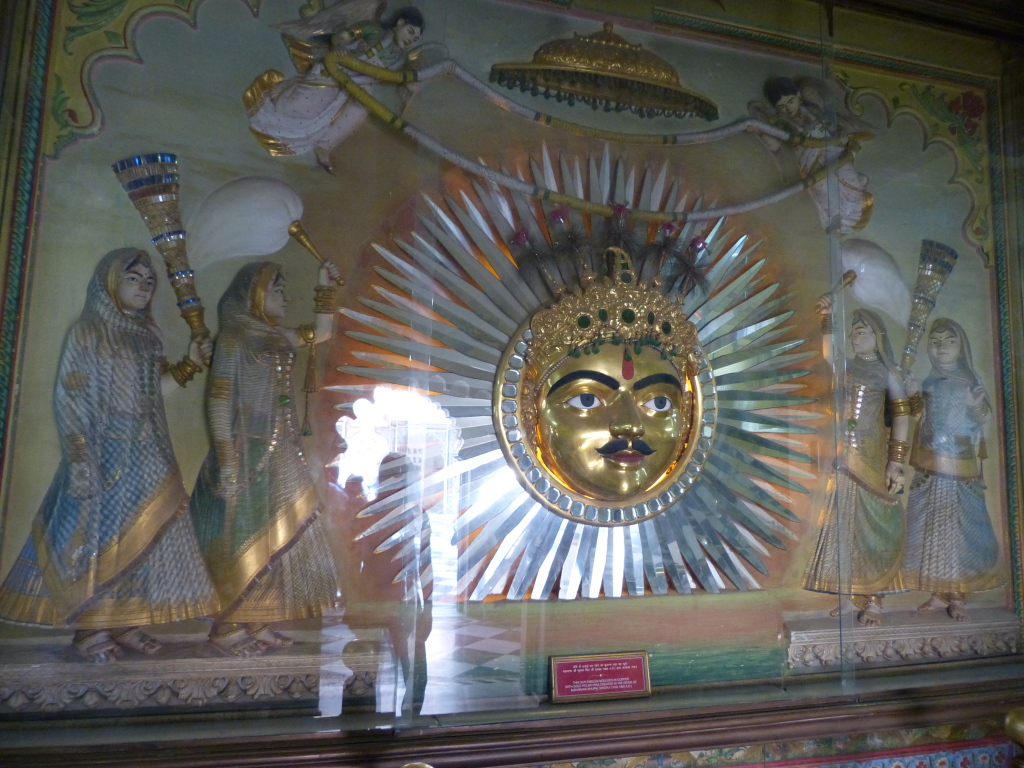
Following our tour, we met up with our tuk-tuk drivers and tried to find a shopping street promoted in several guidebooks. The city was bustling with Diwali shoppers and festival preparation.
This lady was decorating the stoop in front of her bangle shop, where Brenna hit the jackpot.
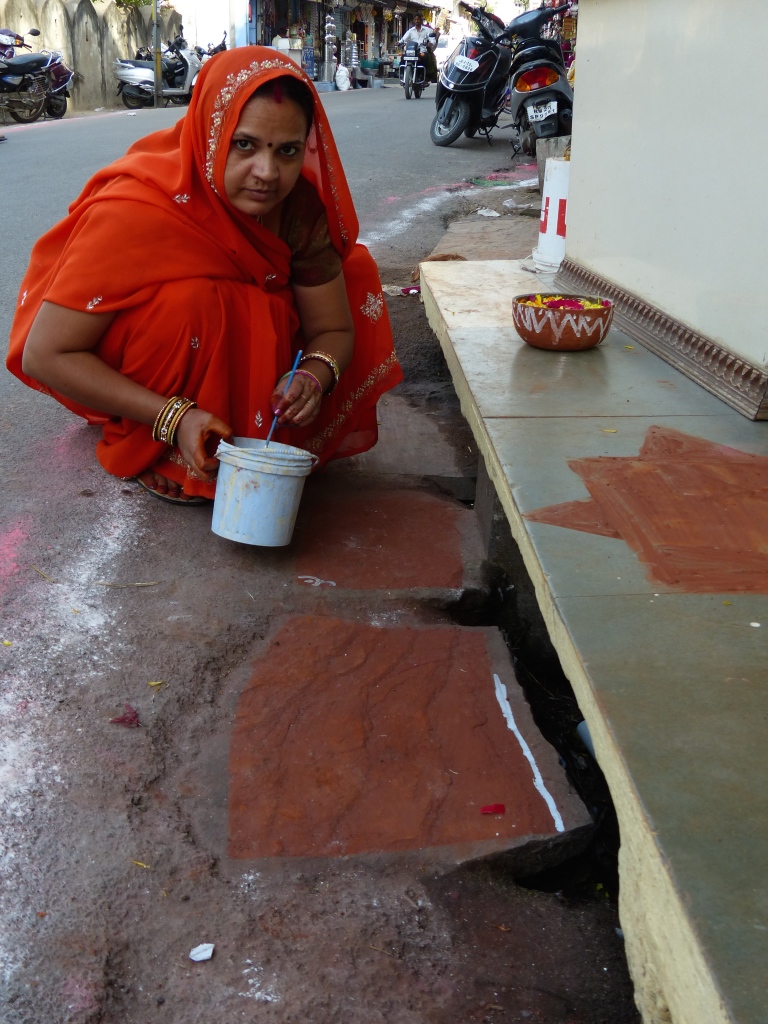
Holiday shoppers and honking vehicles filled the streets, sidewalks and markets. Amjan, one of the tuk-tuk drivers, stopped a few times to ask if we wanted to get out and walk around. No thanks!
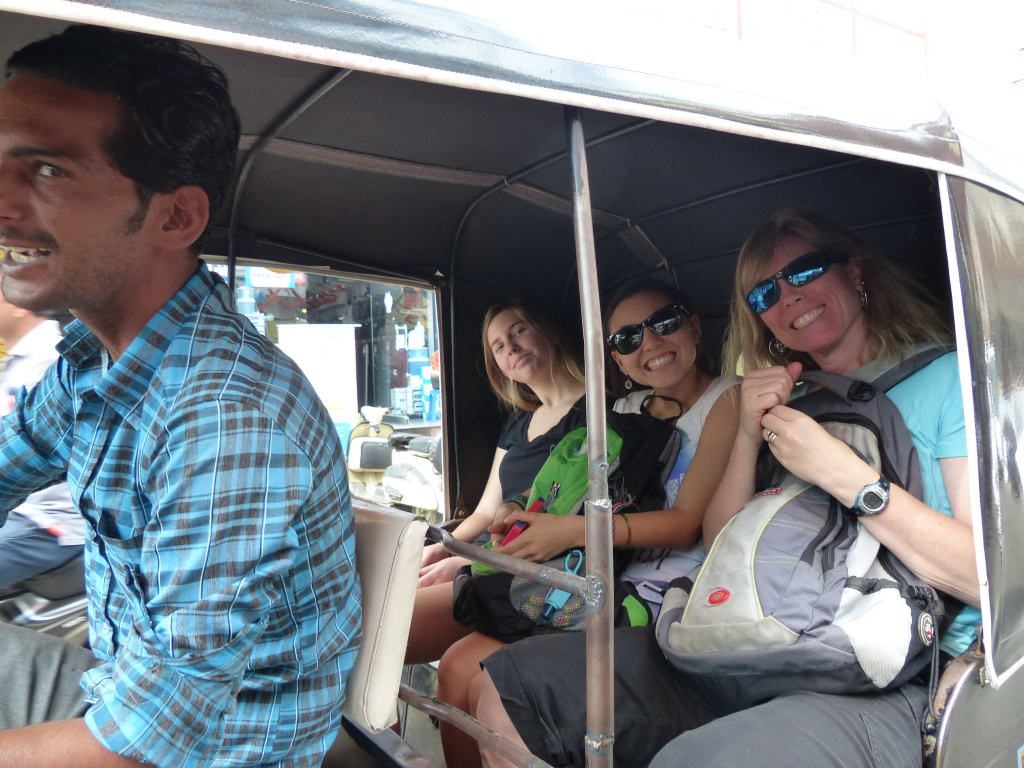
We saw a sign for “rooftop restaurant,” so we climbed about five flights of steep narrow stairs only to find ONE table at the very top! The owner offered us a menu, but it seemed a bit sketchy.
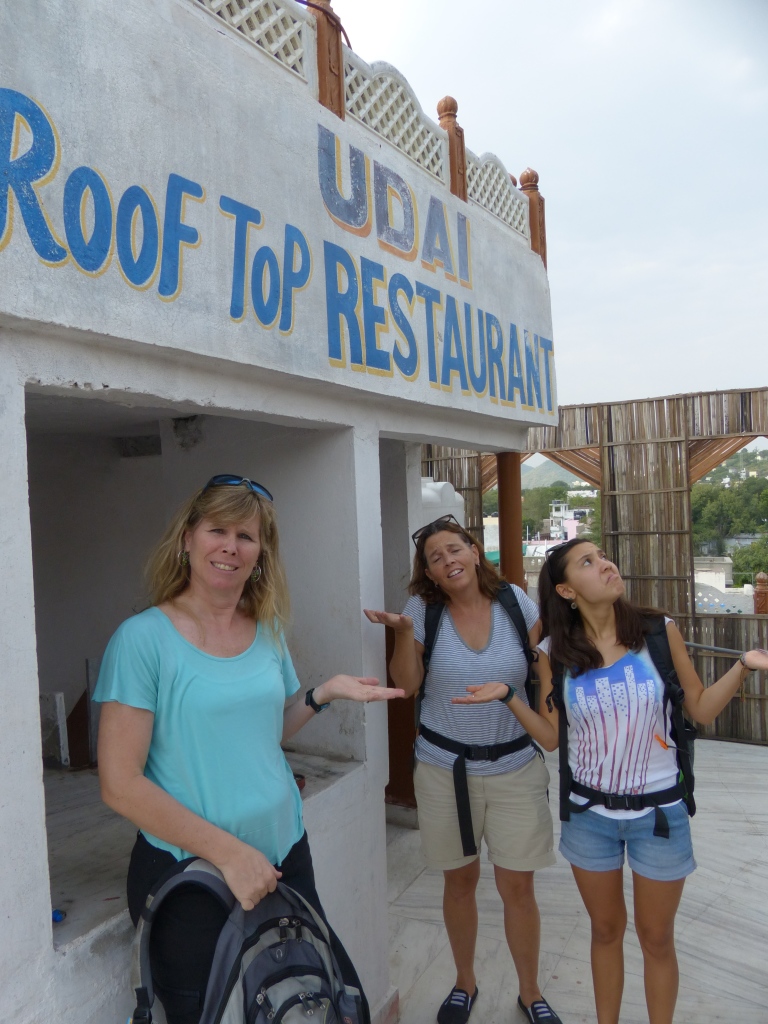
Poor Amjan. I could tell he was frustrated that we couldn’t decide what to do. The crowds were too daunting. We finally asked him to take us to an Indian restaurant, where we had a nice late lunch before heading back to the hotel for the rest of the evening. We hunkered down with cocktails and snacks on the hotel’s deck, but before we knew it, Diwali entertainers were setting up a puppet show. Halfway into the show, we realized we were the only adults in the front row.
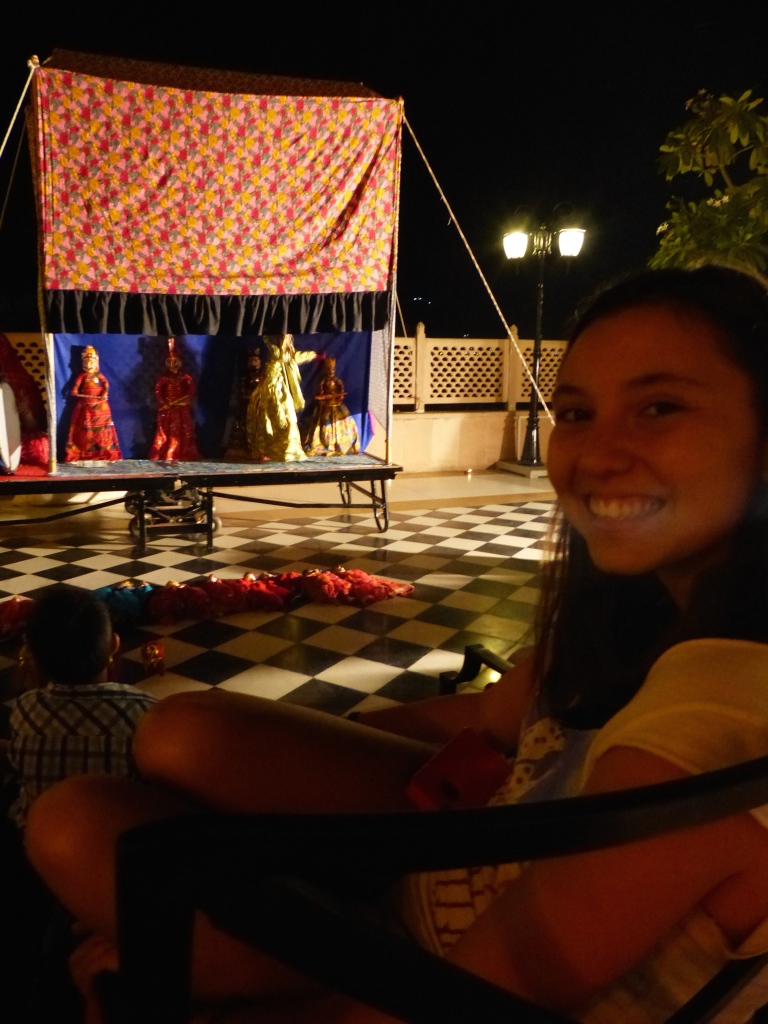
The style of puppetry is called “Kathputli,” an artform purported to be more than 1,000 years old. At our puppet show, a man climbed onto the platform and stayed hidden the whole time, manipulating the puppets, while a woman sat cross-legged next to the makeshift theater, drumming and singing along. I thought the puppeteer was playing tunes on a kazoo, but the website PuppetIndia.com illuminated me:
Rajasthan puppets have their own unique speciality. Puppeteers manipulate the puppets with a whistling, squeaking voice and are interpreted by a narrator who also provides the rhythms. The puppets have no legs and movements are free. Their bodies and limbs are made of mango wood and stuffed with cotton. A slight jerk of the string causes the puppets to produce movements of the hands, neck and shoulder. Many puppets hang on one rope: one string tied to the head and other to the waist. The puppeteer makes a loop around his fingers and manipulates the puppet. He takes ghungru (bells) in his hands and plays it according to rhythm. These puppets have a very limited vocabulary, so the movements play a very important part. Puppets are moved towards each other with speed and with swords in their hands in fighting postures. Greetings and salutations are done by bending the puppets and leaving their arms to hang loosely.
Our second day in Udaipur involved a lot of chilling out, followed by our cooking class with Shashi. We returned to Delhi Saturday morning so Col and Brenna catch their flight back to Hong Kong. Before they left, though, we spent a couple hours at a salon getting pampered.
For more photos from our get-away weekend, check out my flickr album: Udaipur.

